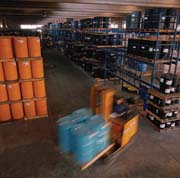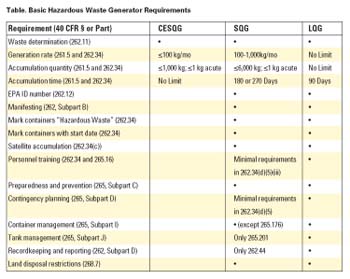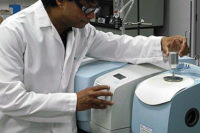
This guide was developed to help processors of polyurethane chemicals manage waste chemicals and empty containers in a responsible manner that conforms to federal and state regulations. In particular, it focuses on those chemicals used in polyurethane processing operations that may be regulated as hazardous waste.
Regulations
Hazardous waste regulations are developed and implemented by the U.S. Environmental Protection Agency (EPA) as directed by Congress in the Resource Conservation and Recovery Act of 1976 (RCRA) and subsequent amendments. The EPA's hazardous waste management regulations are currently codified in 40 CFR Parts 260 to 270, and impose requirements upon hazardous waste generators concerning waste classification, waste accumulation, treatment and disposal, recordkeeping, and emergency preparedness. At the time of publication, the EPA has delegated authority to implement and enforce hazardous waste management programs to 49 states. State regulations may be more stringent or more extensive than the corresponding EPA regulations.What is a Hazardous Waste?
The EPA defines hazardous waste in 40 CFR Part 261. In order for a waste to be hazardous waste it must meet the EPA definition of "solid waste," since hazardous waste is considered a subset of solid waste. The term "solid waste" is used very broadly in RCRA and refers to both nonhazardous and hazardous waste, including not only solids, but also liquids, sludges, and compressed gases. Materials that are being disposed of, or are accumulated, stored, or treated before (or instead) of being disposed of, are solid waste. Also, spent materials that are accumulated, stored or treated before being recycled are usually solid waste. Generally, chemicals stored with no possibility of use or reclamation are solid waste.The EPA has determined that certain solid wastes are hazardous wastes if they may cause an increase in mortality or illness or pose substantial hazard to human health or the environment when improperly managed. A waste is considered hazardous if it: 1.) is listed on one of the lists of hazardous wastes published by EPA in 40 CFR Part 261, Subpart D; or 2.) exhibits one or more of the four hazardous characteristics defined in 40 CFR Part 261, Subpart C. Listed and characteristic hazardous wastes are identified using EPA codes consisting of one letter followed by three digits. Some states may use additional codes for state-unique hazardous waste streams. For example, the hazardous waste code for used oil in Massachusetts is MA98. For listed wastes, the first letter in the code corresponds to the common list name (e.g., "F-List"). The first letter in the codes of characteristic wastes is D. Generators are required by law to identify their hazardous wastes with all applicable codes.
To determine if a waste is a regulated hazardous waste, the generator needs to accomplish three things. First, determine whether the waste fits within the definition of "solid waste" and, if so, whether the waste is excluded from regulation under 40 CFR § 261.4. Next, they need to examine whether the waste is listed as a hazardous waste in 40 CFR Part 261, Subpart D. Finally, the generator needs to consider whether the waste exhibits one or more of the hazardous characteristics identified in 40 CFR Part 261, Subpart C. In making these determinations, generators may use either analytical testing or their knowledge regarding the process that generates the waste. Wastes such as outdated raw materials may not require testing since knowledge of the chemicals' origins and characteristics may be applied in the determination. Material safety data sheets (MSDSs) are often useful for this purpose.

There are four primary lists of hazardous wastes. To determine if a waste is listed, one must have knowledge of the waste's origin. The lists are described briefly below, but complete copies of the hazardous waste lists are included in 40 CFR Part 261.
- F-List [40 CFR § 261.31] - The F-list identifies spent solvents, electroplating wastes, wood-preserving wastes, certain landfill leachates and more. Polyurethane processors may generate F-listed spent solvents (e.g., used methylene chloride, acetone, toluene, etc.). Spent solvents on the F-list are designated by the codes F001, F002, F003, F004 and F005.
- K-List [40 CFR § 261.32] - The K-list identifies wastes from specific industries (e.g., ink formulating, petroleum refineries and metal smelting). It is unlikely that polyurethane processors generate K-listed hazardous waste.
- P-List [40 CFR § 261.33(e)] - The P-list applies to unused discarded commercial chemical products with a sole-active ingredient on the P-list. Also, off-specification materials, container residues and spill residues of P-listed materials are P-listed wastes. P-listed wastes are "acutely hazardous wastes" and are subject to more stringent management standards than other hazardous wastes. It is unlikely that polyurethane processors will generate P-listed hazardous waste; however, processors should review the P-list to be sure. P-listed waste should be separated from other hazardous waste.
- U-List [40 CFR § 261.33(f)] - The U-list is applied to wastes similar to application of the P-list. The U-list applies to unused discarded commercial chemical products with a sole-active ingredient on the U-list. Also, off-specification materials, container residues and spill residues of U-listed materials are U-listed wastes. U-listed wastes are referred to as "toxic wastes." TDI (U223), MOCA (U158), DOP (U107), and methylene chloride (U080) are examples of chemicals used in the polyurethane industry that, upon disposal, may be U-listed hazardous wastes. Although discarded TDI is a U-listed waste, discarded TDI prepolymers are not. In a TDI prepolymer there may be some free TDI, but it is not the "sole active ingredient." On the other hand, if pure TDI were spilled, all of the spill cleanup material would be U223. Similarly, in a B-side formulation with polyol and MOCA, MOCA is not the "sole-active ingredient," therefore the B-side waste would not be listed. However, cleanup of a pure MOCA spill would be U158.
Characteristic Wastes
EPA has identified four hazardous waste characteristics: ignitability, corrosivity, reactivity and toxicity. Generators may use testing or knowledge to determine if their wastes exhibit one or more of the characteristics.
- Ignitability [40 § CFR 261.21] - Ignitable wastes, denoted by the code D001, are generally liquids with flash points below 60°C (140°F).
-
Corrosivity [40 § CFR 261.22] - Corrosive wastes, denoted by the code D002, are generally aqueous solutions with a pH £2 or
Are Mixtures a Hazardous Waste?
Processors should beware of mixing hazardous waste with non-hazardous waste - especially when listed wastes are concerned. In most cases, if a non-hazardous or characteristic waste is mixed with a listed waste, the entire resulting mixture is considered listed hazardous waste and the original listed waste code applies to the mixture. It is advisable to segregate listed wastes from non-hazardous waste because mixing listed waste with non-hazardous waste results in the generation of increased volumes of listed hazardous waste. Under certain circumstances, wastes may be mixed to make a non-hazardous waste. This is particularly true in the polyurethane industry. However, generators need to use caution when mixing hazardous wastes in order to treat wastes. With a few exceptions, facilities treating hazardous waste must have RCRA permits. These exceptions are discussed below.Are Empty Containers Hazardous Wastes?
Empty containers that once held hazardous chemicals are not regulated as hazardous waste if they meet the definition of "empty." A container is empty if all waste has been removed (e.g., by pouring or pumping) and less than one inch of residue remains on the bottom of the container. Generally, there should be no free liquids in an "empty" container. Containers that held acutely hazardous waste (e.g., P-listed waste) are considered empty only after being triple-rinsed with a solvent capable of removing the acutely hazardous waste residue. The solvent rinsate is then managed as acutely hazardous waste. "Empty" containers may not be subject to RCRA, but their disposal still may raise challenges. A few options for managing empty drums are outlined as follows.- Arrange with the raw materials supplier to accept return drums.
- Reuse drums for outgoing product. Obviously this option poses compatibility and contamination issues. Also, this is not a viable option for packaging hazardous materials under transportation regulations.
- Ship empty drums to a drum reconditioner or a scrap recycler. In either case, the reputation of facilities handling empty drums must be carefully checked. (For more information on drum recycling facilities, see http://www.reusablepackaging.org)
- Disposal of drums into local landfills is almost never an option since most landfills have a ban on accepting recognizable drums. In some cases, processors may be able to destroy the drums (e.g., using a drum crusher) and send them to a landfill. Still, sending empty drums to a landfill can pose long-term liability issues if the landfill is ever found to be contaminated. Some processors have found that receiving raw materials in returnable shipping containers (e.g., totes) instead of drums is one of the better options. This requires a negotiated understanding with the supplier.
What Are My Responsibilities as a Hazardous Waste Generator?
The EPA imposes numerous requirements upon hazardous-waste generators, which govern all aspects of a waste-management program, including waste classification, storage, reporting and recordkeeping, and training. However, hazardous-waste generators are subject to varying requirements depending on how much hazardous waste they generate monthly. Under EPA rules, there are three classes of generators: large-quantity generators (LQGs), small-quantity generators (SQGs), and conditionally exempt small quantity generators (CESQGs). SQGs and LQGs are subject to more hazardous waste management requirements as depicted in the table, while CESQGs are usually subject to very minimal regulation (in most states). Some states define generator status differently and set more stringent or different requirements upon SQGs and CESQGs. Because a facility's generator status is determined on a monthly basis, it is possible that a facility may be subject to different requirements throughout the year. For example, if a facility generates less than 100 kilograms of hazardous waste in January, it would be considered a CESQG and subject to the less onerous hazardous waste management requirements for that type of facility. If the same facility generates 500 kilograms of hazardous waste in February, its status would change to SQG and the facility would be subject to the hazardous-waste management requirements applicable to that type of facility. For continued compliance, some facilities choose to meet the more stringent requirements at all times if they know that their facility is likely to change generator status multiple times throughout the year. The table presents an overview of EPA hazardous waste management requirements that apply to processors depending upon their generator status.How Do I Store Hazardous Waste?
Satellite AccumulationWhen hazardous waste is accumulating at the point where it is initially generated and is under the control of the process operator generating that waste, it is considered to be in a "satellite accumulation area" and is subject to minimal regulatory requirements (40 CFR §262.34(c)). Specifically, hazardous waste containers must remain closed except when adding waste; containers must be marked with the words "hazardous waste" or other words that identify the containers' contents; containers must be in good condition and compatible with the wastes they contain; and no more than 55 gal of hazardous waste or one quart of acutely hazardous waste may be stored at each satellite accumulation area.
Hazardous Waste in a Designated Accumulation Area
Once hazardous waste leaves the satellite accumulation area and enters a different location, referred to here as an accumulation area, it is subject to more stringent management standards. When waste leaves the satellite accumulation area, "the clock starts," and from this date, the waste must be shipped off-site to a permitted hazardous waste treatment, storage or disposal facility (TSDF) within 90, 180 or 270 days, depending on the generator's status (e.g., CESQG, SQG, or LQG) and distance from the TSDF (40 CFR § 262.34).
In the accumulation area, all hazardous waste containers must be clearly marked with the date they entered the area. All containers must be clearly marked "hazardous waste." Emergency equipment must be maintained at the accumulation area and periodically tested to ensure it is in working order (e.g., communications device or alarm system, fire extinguishers, spill control equipment, etc.). Waste containers must be arranged in the accumulation area so that there is adequate aisle space to allow for the flow of emergency personnel and equipment. Incompatible wastes must be separated to the extent possible using distance, berms or containment pans. The accumulation area must be inspected weekly for leaks and deterioration, and to ensure adequate spill response materials are on-hand.
How Do I Dispose of Hazardous Waste?
Most processors ship hazardous waste to permitted TSDFs. As specified in the EPA regulations, these shipments must comply with the U.S. Department of Transportation (DOT) Hazardous Materials Regulations, 49 CFR Parts 171-180. Hazardous waste shipments must be accompanied by a hazardous waste manifest (shipping paper) and must be transported by an EPA-permitted transporter (40 CFR Part 262 Subpart B). Processors should ensure that their waste is shipped to a reputable, permitted TSDF in order to avoid potential future liabilities.Prior to off-site disposal, careful waste segregation is important for both safety and economic reasons. For example, if methylene chloride waste is mixed with a B-side polyol blend, then more hazardous waste is generated and the cost of disposal will escalate because of the chlorine content, which decreases the opportunity for fuel blending the polyol or recycling the methylene chloride. Fuel blending and recycling generally are less expensive options and can be more responsible stewardship than conventional hazardous waste incineration. Potential liability arises from the disposal of all chemical wastes, most particularly hazardous waste. Under the Comprehensive Environmental Response, Compensation and Liability Act (CERCLA or "Superfund"), a person who arranges for the disposal or treatment, or transportation for disposal or treatment, of a hazardous substance can be held liable for any future remedial costs associated with those substances. Hazardous wastes qualify as hazardous substances under CERCLA, as do MDI, TDI and other products used in the polyurethane industry. In order to limit potential liability, processors should ensure that all wastes are disposed, treated and transported properly by licensed, reputable firms.
May I Treat or Dispose of My Hazardous Waste On-Site?
In limited circumstances, processors may treat hazardous waste on-site. However, before treating, hazardous waste processors should be sure that the treatment they are planning does not require an RCRA treatment permit. In fact, with few exceptions, on-site treatment requires a RCRA permit. RCRA permits are extremely costly and time-consuming to obtain, but treating a hazardous waste without a permit when one is required can subject processors to huge fines or criminal prosecution for noncompliance. One widely applied type of hazardous waste treatment that the EPA allows without a permit is elementary neutralization (adjusting the pH of an acidic or basic solution). The EPA also allows generators to treat hazardous waste in accumulation containers without a permit, provided that the containers are managed in compliance with the EPA's container management standards in 40 CFR Part 265, Subpart I. The EPA states this exemption in its Federal Register notice dated March 24, 1986 (51 FR 10168), as well as in subsequent FR notices and interpretive memos. This allowance is quite broad in that it does not limit what type of treatment may take place (e.g., precipitation, oxidation/reduction, polymerization). Still, when treating a listed hazardous waste, generally the treatment residue carries the listing of the original hazardous waste. Therefore, the usefulness of this allowance is limited for listed wastes.For example, excess, pure TDI waste reacted with a polyol would form an inert polyurethane that may be regulated as U223 hazardous waste. However, excess MDI waste reacted with polyol would not result in a regulated material because MDI is not a U-listed chemical. Although some treatment of hazardous wastes without a permit is allowed by most states, processors are cautioned to check with their state regulators before treating any hazardous waste.
Keep in mind that permits for treatment are only required for RCRA "hazardous wastes" and state-regulated waste streams. Processors may treat wastes that are not regulated as hazardous. In many cases, excess A-side (isocyanate) and B-side (polyol) formulations may be reacted to make non-hazardous solids that may be disposed of with regular trash. Regardless, check with the waste transporter and disposal facility before mixing any non-hazardous waste streams together or with the regular plant trash.
From Guidelines for the Responsible Disposal of Wastes and Containers from Polyurethane Processing, the Alliance for the Polyurethanes Industry. For more information, phone (703) 741-5656 or visit http://www.polyurethane.org.SIDEBAR: Online Resources
1. http://www.epa.gov, EPA's official website.2. http://www.epa.gov/epaoswer/osw, Links to information concerning permits, storage, disposal, recycling, and identification of hazardous waste and EPA regulations.
3. http://www.epa.gov/rcraonline, RCRA Online - enables search for questions/answers; guidance documents on all aspects of the EPA's hazardous waste regulations.
4. http://www.atsdr.cdc.gov, Agency for Toxic Substances and Disease Registry - health effects and minimum risk levels of hazardous chemicals.
5. http://www.epa.gov/estpages/wasthazardouswaste.html, Contains links to hazardous waste and RCRA information within EPA.
6. http://www.epa.gov/epaoswer/osw/regions.htm, Link to regional EPA and state hazardous waste offices.
7. http://www.osha.gov/SLTC/hazardouswaste, Safety and health information for hazardous waste handlers (PPE, training, etc.).
8. http://hazmat.dot.gov, DOT HazMat site - information regarding regulations governing the transportation of hazardous materials.

